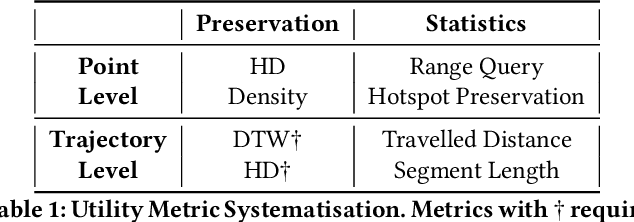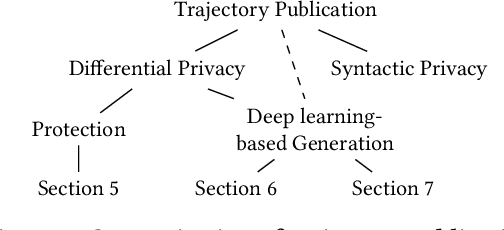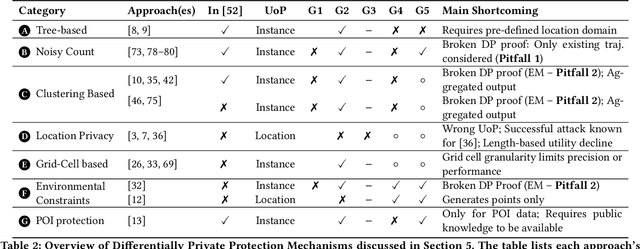Surya Nepal
What is the Cost of Differential Privacy for Deep Learning-Based Trajectory Generation?
Jun 11, 2025Abstract:While location trajectories offer valuable insights, they also reveal sensitive personal information. Differential Privacy (DP) offers formal protection, but achieving a favourable utility-privacy trade-off remains challenging. Recent works explore deep learning-based generative models to produce synthetic trajectories. However, current models lack formal privacy guarantees and rely on conditional information derived from real data during generation. This work investigates the utility cost of enforcing DP in such models, addressing three research questions across two datasets and eleven utility metrics. (1) We evaluate how DP-SGD, the standard DP training method for deep learning, affects the utility of state-of-the-art generative models. (2) Since DP-SGD is limited to unconditional models, we propose a novel DP mechanism for conditional generation that provides formal guarantees and assess its impact on utility. (3) We analyse how model types - Diffusion, VAE, and GAN - affect the utility-privacy trade-off. Our results show that DP-SGD significantly impacts performance, although some utility remains if the datasets is sufficiently large. The proposed DP mechanism improves training stability, particularly when combined with DP-SGD, for unstable models such as GANs and on smaller datasets. Diffusion models yield the best utility without guarantees, but with DP-SGD, GANs perform best, indicating that the best non-private model is not necessarily optimal when targeting formal guarantees. In conclusion, DP trajectory generation remains a challenging task, and formal guarantees are currently only feasible with large datasets and in constrained use cases.
Adversarially Guided Stateful Defense Against Backdoor Attacks in Federated Deep Learning
Oct 15, 2024Abstract:Recent works have shown that Federated Learning (FL) is vulnerable to backdoor attacks. Existing defenses cluster submitted updates from clients and select the best cluster for aggregation. However, they often rely on unrealistic assumptions regarding client submissions and sampled clients population while choosing the best cluster. We show that in realistic FL settings, state-of-the-art (SOTA) defenses struggle to perform well against backdoor attacks in FL. To address this, we highlight that backdoored submissions are adversarially biased and overconfident compared to clean submissions. We, therefore, propose an Adversarially Guided Stateful Defense (AGSD) against backdoor attacks on Deep Neural Networks (DNNs) in FL scenarios. AGSD employs adversarial perturbations to a small held-out dataset to compute a novel metric, called the trust index, that guides the cluster selection without relying on any unrealistic assumptions regarding client submissions. Moreover, AGSD maintains a trust state history of each client that adaptively penalizes backdoored clients and rewards clean clients. In realistic FL settings, where SOTA defenses mostly fail to resist attacks, AGSD mostly outperforms all SOTA defenses with minimal drop in clean accuracy (5% in the worst-case compared to best accuracy) even when (a) given a very small held-out dataset -- typically AGSD assumes 50 samples (<= 0.1% of the training data) and (b) no heldout dataset is available, and out-of-distribution data is used instead. For reproducibility, our code will be openly available at: https://github.com/hassanalikhatim/AGSD.
Honeyfile Camouflage: Hiding Fake Files in Plain Sight
May 08, 2024Abstract:Honeyfiles are a particularly useful type of honeypot: fake files deployed to detect and infer information from malicious behaviour. This paper considers the challenge of naming honeyfiles so they are camouflaged when placed amongst real files in a file system. Based on cosine distances in semantic vector spaces, we develop two metrics for filename camouflage: one based on simple averaging and one on clustering with mixture fitting. We evaluate and compare the metrics, showing that both perform well on a publicly available GitHub software repository dataset.
Contextual Chart Generation for Cyber Deception
Apr 07, 2024Abstract:Honeyfiles are security assets designed to attract and detect intruders on compromised systems. Honeyfiles are a type of honeypot that mimic real, sensitive documents, creating the illusion of the presence of valuable data. Interaction with a honeyfile reveals the presence of an intruder, and can provide insights into their goals and intentions. Their practical use, however, is limited by the time, cost and effort associated with manually creating realistic content. The introduction of large language models has made high-quality text generation accessible, but honeyfiles contain a variety of content including charts, tables and images. This content needs to be plausible and realistic, as well as semantically consistent both within honeyfiles and with the real documents they mimic, to successfully deceive an intruder. In this paper, we focus on an important component of the honeyfile content generation problem: document charts. Charts are ubiquitous in corporate documents and are commonly used to communicate quantitative and scientific data. Existing image generation models, such as DALL-E, are rather prone to generating charts with incomprehensible text and unconvincing data. We take a multi-modal approach to this problem by combining two purpose-built generative models: a multitask Transformer and a specialized multi-head autoencoder. The Transformer generates realistic captions and plot text, while the autoencoder generates the underlying tabular data for the plot. To advance the field of automated honeyplot generation, we also release a new document-chart dataset and propose a novel metric Keyword Semantic Matching (KSM). This metric measures the semantic consistency between keywords of a corpus and a smaller bag of words. Extensive experiments demonstrate excellent performance against multiple large language models, including ChatGPT and GPT4.
SoK: Can Trajectory Generation Combine Privacy and Utility?
Mar 12, 2024



Abstract:While location trajectories represent a valuable data source for analyses and location-based services, they can reveal sensitive information, such as political and religious preferences. Differentially private publication mechanisms have been proposed to allow for analyses under rigorous privacy guarantees. However, the traditional protection schemes suffer from a limiting privacy-utility trade-off and are vulnerable to correlation and reconstruction attacks. Synthetic trajectory data generation and release represent a promising alternative to protection algorithms. While initial proposals achieve remarkable utility, they fail to provide rigorous privacy guarantees. This paper proposes a framework for designing a privacy-preserving trajectory publication approach by defining five design goals, particularly stressing the importance of choosing an appropriate Unit of Privacy. Based on this framework, we briefly discuss the existing trajectory protection approaches, emphasising their shortcomings. This work focuses on the systematisation of the state-of-the-art generative models for trajectories in the context of the proposed framework. We find that no existing solution satisfies all requirements. Thus, we perform an experimental study evaluating the applicability of six sequential generative models to the trajectory domain. Finally, we conclude that a generative trajectory model providing semantic guarantees remains an open research question and propose concrete next steps for future research.
A2C: A Modular Multi-stage Collaborative Decision Framework for Human-AI Teams
Jan 25, 2024Abstract:This paper introduces A2C, a multi-stage collaborative decision framework designed to enable robust decision-making within human-AI teams. Drawing inspiration from concepts such as rejection learning and learning to defer, A2C incorporates AI systems trained to recognise uncertainty in their decisions and defer to human experts when needed. Moreover, A2C caters to scenarios where even human experts encounter limitations, such as in incident detection and response in cyber Security Operations Centres (SOC). In such scenarios, A2C facilitates collaborative explorations, enabling collective resolution of complex challenges. With support for three distinct decision-making modes in human-AI teams: Automated, Augmented, and Collaborative, A2C offers a flexible platform for developing effective strategies for human-AI collaboration. By harnessing the strengths of both humans and AI, it significantly improves the efficiency and effectiveness of complex decision-making in dynamic and evolving environments. To validate A2C's capabilities, we conducted extensive simulative experiments using benchmark datasets. The results clearly demonstrate that all three modes of decision-making can be effectively supported by A2C. Most notably, collaborative exploration by (simulated) human experts and AI achieves superior performance compared to AI in isolation, underscoring the framework's potential to enhance decision-making within human-AI teams.
Multiple Hypothesis Dropout: Estimating the Parameters of Multi-Modal Output Distributions
Dec 18, 2023Abstract:In many real-world applications, from robotics to pedestrian trajectory prediction, there is a need to predict multiple real-valued outputs to represent several potential scenarios. Current deep learning techniques to address multiple-output problems are based on two main methodologies: (1) mixture density networks, which suffer from poor stability at high dimensions, or (2) multiple choice learning (MCL), an approach that uses $M$ single-output functions, each only producing a point estimate hypothesis. This paper presents a Mixture of Multiple-Output functions (MoM) approach using a novel variant of dropout, Multiple Hypothesis Dropout. Unlike traditional MCL-based approaches, each multiple-output function not only estimates the mean but also the variance for its hypothesis. This is achieved through a novel stochastic winner-take-all loss which allows each multiple-output function to estimate variance through the spread of its subnetwork predictions. Experiments on supervised learning problems illustrate that our approach outperforms existing solutions for reconstructing multimodal output distributions. Additional studies on unsupervised learning problems show that estimating the parameters of latent posterior distributions within a discrete autoencoder significantly improves codebook efficiency, sample quality, precision and recall.
Parameter-Saving Adversarial Training: Reinforcing Multi-Perturbation Robustness via Hypernetworks
Sep 28, 2023



Abstract:Adversarial training serves as one of the most popular and effective methods to defend against adversarial perturbations. However, most defense mechanisms only consider a single type of perturbation while various attack methods might be adopted to perform stronger adversarial attacks against the deployed model in real-world scenarios, e.g., $\ell_2$ or $\ell_\infty$. Defending against various attacks can be a challenging problem since multi-perturbation adversarial training and its variants only achieve suboptimal robustness trade-offs, due to the theoretical limit to multi-perturbation robustness for a single model. Besides, it is impractical to deploy large models in some storage-efficient scenarios. To settle down these drawbacks, in this paper we propose a novel multi-perturbation adversarial training framework, parameter-saving adversarial training (PSAT), to reinforce multi-perturbation robustness with an advantageous side effect of saving parameters, which leverages hypernetworks to train specialized models against a single perturbation and aggregate these specialized models to defend against multiple perturbations. Eventually, we extensively evaluate and compare our proposed method with state-of-the-art single/multi-perturbation robust methods against various latest attack methods on different datasets, showing the robustness superiority and parameter efficiency of our proposed method, e.g., for the CIFAR-10 dataset with ResNet-50 as the backbone, PSAT saves approximately 80\% of parameters with achieving the state-of-the-art robustness trade-off accuracy.
RAI4IoE: Responsible AI for Enabling the Internet of Energy
Sep 20, 2023



Abstract:This paper plans to develop an Equitable and Responsible AI framework with enabling techniques and algorithms for the Internet of Energy (IoE), in short, RAI4IoE. The energy sector is going through substantial changes fueled by two key drivers: building a zero-carbon energy sector and the digital transformation of the energy infrastructure. We expect to see the convergence of these two drivers resulting in the IoE, where renewable distributed energy resources (DERs), such as electric cars, storage batteries, wind turbines and photovoltaics (PV), can be connected and integrated for reliable energy distribution by leveraging advanced 5G-6G networks and AI technology. This allows DER owners as prosumers to participate in the energy market and derive economic incentives. DERs are inherently asset-driven and face equitable challenges (i.e., fair, diverse and inclusive). Without equitable access, privileged individuals, groups and organizations can participate and benefit at the cost of disadvantaged groups. The real-time management of DER resources not only brings out the equity problem to the IoE, it also collects highly sensitive location, time, activity dependent data, which requires to be handled responsibly (e.g., privacy, security and safety), for AI-enhanced predictions, optimization and prioritization services, and automated management of flexible resources. The vision of our project is to ensure equitable participation of the community members and responsible use of their data in IoE so that it could reap the benefits of advances in AI to provide safe, reliable and sustainable energy services.
Stealthy Physical Masked Face Recognition Attack via Adversarial Style Optimization
Sep 18, 2023Abstract:Deep neural networks (DNNs) have achieved state-of-the-art performance on face recognition (FR) tasks in the last decade. In real scenarios, the deployment of DNNs requires taking various face accessories into consideration, like glasses, hats, and masks. In the COVID-19 pandemic era, wearing face masks is one of the most effective ways to defend against the novel coronavirus. However, DNNs are known to be vulnerable to adversarial examples with a small but elaborated perturbation. Thus, a facial mask with adversarial perturbations may pose a great threat to the widely used deep learning-based FR models. In this paper, we consider a challenging adversarial setting: targeted attack against FR models. We propose a new stealthy physical masked FR attack via adversarial style optimization. Specifically, we train an adversarial style mask generator that hides adversarial perturbations inside style masks. Moreover, to ameliorate the phenomenon of sub-optimization with one fixed style, we propose to discover the optimal style given a target through style optimization in a continuous relaxation manner. We simultaneously optimize the generator and the style selection for generating strong and stealthy adversarial style masks. We evaluated the effectiveness and transferability of our proposed method via extensive white-box and black-box digital experiments. Furthermore, we also conducted physical attack experiments against local FR models and online platforms.
 Add to Chrome
Add to Chrome Add to Firefox
Add to Firefox Add to Edge
Add to Edge